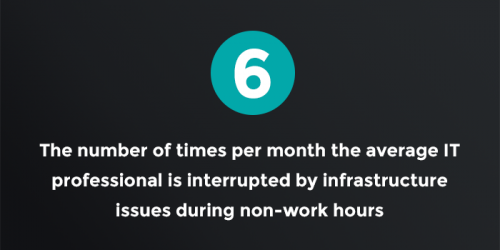
How often do urgent work issues interrupt your non-work hours?
If you’re the average IT pro, you’re picking up the phone or getting out of bed and rushing to your computer six times a month to address IT infrastructure issues, according to our latest survey, The State of Infrastructure Management.
This may be surprising to those outside the function, but the reality is that IT is always on call to ensure that critical systems are up and running—a monumental task in and of itself.
But as IT has transformed into something more than just the help desk or the ones who “keep the lights on,” it’s hard to get over the fact that infrastructure upkeep is interrupting—and blocking—more value-added activities. Nearly eight in 10 respondents to our survey believe they could bring more value to their organizations if they spent less time on routine tasks like server monitoring and maintenance.
This isn’t IT wanting to jettison responsibility just because it’s tedious or hard.
It’s IT pros recognizing that they could be adding more value to their function and their organization—if only they had the time.
How IT pros spend their time is not just a matter of individual value; it’s about maximizing the value of the IT function as a whole, increasing productivity and morale, and remembering the human element behind the IT infrastructure that powers the entire enterprise.
The Problem of Morale
We asked 500 IT professionals: If you got back 16 hours of your week normally devoted to routine infrastructure tasks, what would you do with that time? Their No. 1 answer? Reclaim work-life balance.
It’s hard to read this as anything more than a warning sign of the downsides of IT pros feeling overworked—or even underappreciated, as we found when we asked respondents about the one thing they wish their CEO knew about their role. Many identified both the long hours and the lack of recognition for the unique value IT brings to the enterprise.
“I wish my CEO knew how close we are at times to totally losing it,” one said. “I wish my CEO knew how much work we put in to keep problems at bay; they only acknowledge us when something goes wrong,” said another.
Maximizing the value IT contributes to the business as a whole is just as much about what IT practitioners do as how they feel about it. To have an innovative IT organization carrying out value-added initiatives, not just scrambling to maintain and keep up, the IT pros doing the work need the time, energy and motivation to do so.
How can you ensure you have all three? We’ll get to that later. First, let’s turn to what IT is actually spending their time on—and what they’re not.
The Value-Added Activities IT Wants to Be Doing
Roughly the same amount of IT pros (82 percent) have one server- or cloud-related task they believe they spend too much time on as those who have one task they believe they don’t spend enough time on (77 percent). This indicates a widespread dissatisfaction with day-to-day time allocation among IT pros.
By and large, tasks they spend too much time on are all related to the routine maintenance and upkeep of infrastructure, whether OS or hardware maintenance, server room/data center management, user administration and access control, or monitoring. It’s no wonder then that these are the tasks IT would choose to offload if they could, in favor of more value-added activities.
What are those? The IT pros we surveyed identified two main tasks they don’t feel they spend enough time on: 1.) designing or implementing new solutions and 2.) server migration, expansion and upgrades. Both activities indicate a desire to continue exploring how to further develop the IT organization’s ability to meet the future needs of the business.
The takeaway? IT is hungry to do more, to bring more value through forward-thinking, strategic work, but they feel blocked because they lack the time and resources to break from the never-ending work of upkeep.
So then the question is: What can you do about it?
The Power of Removing Responsibilities
You may have already picked up on the deceptively straightforward answer to the problem of IT’s time under siege: removing the day-to-day routine tasks of maintenance and upkeep. But of course, the hard part is not identifying what to do but how to do it.
That being said, start with looking at the tasks your IT can and should handle in-house and what can be offloaded. Once you’ve identified for your own organization what you can and should take off your IT organization’s plate, finding a trusted managed services provider is one highly effective way to free up time.
They can handle the tasks that are getting in the way of your IT team’s ability to move the needle for your business’s digital transformation and innovation efforts. But beyond that, you will be creating space for IT professionals to reclaim the mental energy, time and resources—both individually and collectively—that they need to maximize their contributions and value to the business as a whole.





